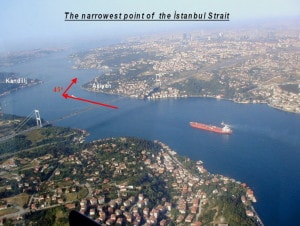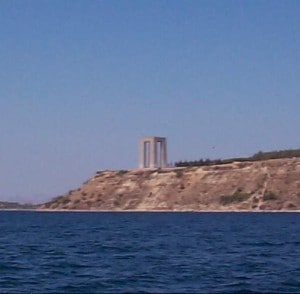 Captain Albert Schoonderbeek
Captain Albert Schoonderbeek
Sometimes the best is saved for last and this was certainly the case this time. With the cruise slowly coming to an end, the transits of today were a big highlight of the cruise. We had sun shine all day and the thus all the sights were clearly visible, as the cruise schedule had been planned in such a way that both transits would be made during day light. For somebody who would follow the ship from a distance it would look rather strange. On departure from Sevastopol we went full ahead crossing the Black Sea. Then for the transit of the Bosporus we went slow with an average speed of 14 knots and then we cranked the Prinsendam up again to full ahead for the crossing of the Sea of Marmara; and then we went down again to 14 knots for the Dardanelles. Once clear of the strait we continued with a speed with 18 knots for an early arrival in Piraeus. To a cargo ship captain this would never make sense.
At the decent time of 08.15 we arrived at Turkili lighthouse at the North entrance of the Bosporus to pick up the pilot. Contrary to the Dardanelles, Pilotage is compulsory here for all ships and with the many ships passing, each day around 150, pilot boats were racing hither and dither to service the ships coming by. About 75 ships were at anchor waiting for a transit but as we are a passenger ship, the scheduling of all the transits is arranged around our arrival time. There is only one sort of ship more important and that is a gas tanker. Then they close the strait down for all traffic.

The Bosporus, looking in the direction towards Istanbul, the way we travelled South this time. Photo courtesy Turkish Pilots.
The one issue with the Bosporus is that the current can reach four knots. This time we had the current with us, which makes the transit faster, but as you are being “flushed through the hole” the current also pushes you towards the shore when going around the two sharp corners in the Bosporus. The Prinsendam steers very well but still I had to pay close attention to make certain that the pilot applied enough momentum to the swing to make sure that we were not suddenly docking half way through the Bosporus on one of the shores. By 09.30 we were past Istanbul and disembarked the pilot. Then it was time to crank up the engines to full sea speed while sailing by about a hundred or more cargo ships, all waiting for a transit or a docking place in one of the numerous docks in Istanbul.
Transiting the Sea of Marmara takes about 5 hours and thus by 15.15 we were at the pilot of Gelibolu at the North entrance of the Dardanelles. This strait is not as narrow as the Bosporus and thus the current is less strong. Still we had all the way through the strait about 2 miles of current with us. There is a speed limit of 15 knots and that meant that I had to adjust the speed of the Prinsendam constantly. 15 knots was to be ground speed which is the ships speed through the water, plus the extra speed gained from the pushing current. When the shore comes closer and thus the strait gets narrows there is less room for the water to flow and that increases the current and thus the ships speed. Hence, the slowing down and speeding up of the engines to retain a maximum of 15 knots.

The Turkish war monument dominates the North shore of the entrance to the Dardanelles when coming from the West.
There is one narrow spot in the Dardanelles, were the strait is only 3000 feet wide. That is at the town of Canakkale where opposite a strong fortress guards the bend in the strait. Once past; the monuments of the First World War come into view with the Turkish war memorial dominating the horizon. There are of course more of them, but they are less imposing. It was a grand day for sightseeing and the feed back from the guests was one of great satisfaction.
From the Dardanelles we set out for Piraeus. I have been asked to be an hour earlier than planned, (very bad for my fuel consumption) as otherwise I had to wait a long time for ferries arriving and departing. That might endanger the departure time of the tours, so I had better be early.
Again beautiful weather is predicted and we are docking at the best cruise berth in Piraeus.
Note: I managed to (finally) upload the history of the Obdam of 1889 which I had prepared some time ago.
The Obdam 1889. Bad Weather, Mutiny and Sick Soldiers can be found at the right hand side of the main page under HAL History.
To access Captain Albert’s historical writings on Holland America Line as well as photos and additional information about Prinsendam and his sailing schedule, click here.

Leave a Reply